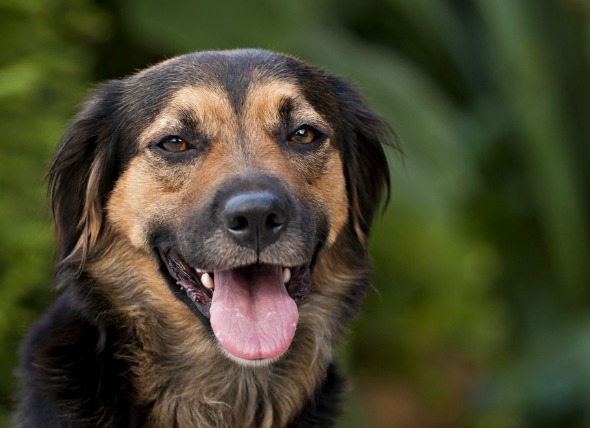

The respiratory system has many parts, but the two important parts of the upper respiratory system are the nose and paranasal sinuses. The paranasal sinuses are hollow spaces in the bones of the skull. They connect with the nose and help to add moisture to the air that a dog breathes in through its nose. Both the inside of the nose and the paranasal sinuses are covered in the same type of tissue, called the epithelium. The outer layer of this tissue is scale like, and is called the squamous epithelium. Tumors that grow from this squamous epithelium are called squamous cell carcinomas.
Squamous cell carcinomas are the second most common type of nasal tumor that dogs get. They usually grow slowly over several months. Most commonly, they occur on both sides of the nose, and it is common for this kind of cancer to spread to the bone and tissue near it. In some cases, this type of nasal tumor will spread to the brain, causing seizures. Squamous cell carcinomas in the nose and sinuses are usually seen in dogs over nine years old, but they have been seen in dogs as young as three years old.
There are currently no known causes for this type of nasal tumor.
You will need to provide a thorough history of your dog's health leading up to the onset of symptoms. A complete blood count and biochemical profile will be ordered. The results of these tests will indicate if there is an infections that is causing your dog's symptoms. Samples of your dog's nasal discharge will also indicate if there are any infections present in the mucus.
Your veterinarian will order X-rays of your dog's head and chest to determine whether a tumor is present, now large it is and whether it has invaded the bone or spread to the lungs. Your veterinarian may also order a computed tomography (CT) or magnetic resonance (MRI) scan of your dog's head in order to get a more detailed image of the tumor and the inside of your dog's skull. These will help your veterinarian to determine how advanced the tumor is and how it might best be treated.
Biopsies are an essential diagnostic tool for determining the exact type of carcinoma that is affecting your dog. Your veterinarian will order a biopsy of the tumor in your dog's nose as well as a bioptic sample from the lymph nodes. The results of the laboratory tests from the lymph fluid will indicate whether the carcinoma has spread to other organs.
Squamous cell carcinomas in the nose and sinuses are treated with a combination of surgery, radiation therapy, and chemotherapy. If your dog has surgery, the part of the sinuses that are affected by the tumor will be removed during surgery. After your dog has recovered from surgery, your veterinarian may recommend radiation therapy or chemotherapy. For some types of radiation therapy, your dog may need to stay in the hospital.
In some cases, surgery may not be practical and your dog may be treated with radiation or chemotherapy alone. Some forms of radiation therapy are just as effective as the combination of surgery and radiation. Your veterinarian will counsel you on the possible treatments that are available.
It is common for a dog that has been affected with a squamous cell carcinoma of the nose or sinuses to have nasal discharge and inflammation after surgery and radiation therapy. These symptoms usually go away in in the course of several weeks. Fungal infections are also possible in its nose after surgery. Your veterinarian will tell you what to look for and will help you monitor your dog for these infections. As with many carcinomas, it is common for these tumors to recur after treatment. Usually when they return, they have spread (or metastasized) to the brain. Some dogs can do well for up to a year after treatment.
 Retained Testicles Dogs
Cryptorchidism in Dogs
The testes normally descen
Retained Testicles Dogs
Cryptorchidism in Dogs
The testes normally descen
 Dog Abdominal Cavity Inflammation - Dog Peritoneal Cavity
Peritonitis in Dogs
The abdominal cavity is lined
Dog Abdominal Cavity Inflammation - Dog Peritoneal Cavity
Peritonitis in Dogs
The abdominal cavity is lined
 Heart Attack in Dogs
Myocardial Infarction in Dogs
Much like in humans
Heart Attack in Dogs
Myocardial Infarction in Dogs
Much like in humans
 Mouth Cancer in Dogs
Undifferentiated Oral Cavity Tumors in Dogs
Undif
Mouth Cancer in Dogs
Undifferentiated Oral Cavity Tumors in Dogs
Undif
 Low Platelet Count in Dogs
Thrombocytopenia in Dogs
Thrombocytopenia is a me
Low Platelet Count in Dogs
Thrombocytopenia in Dogs
Thrombocytopenia is a me
Copyright © 2005-2016 Pet Information All Rights Reserved
Contact us: www162date@outlook.com